Robo Explains it All
Before we get to quest 13, the denouement of the tragedy, weíre going to take a look back at the first 12 quests to show you how Chrono Trigger has been deceiving the player this entire time. Take a look at the chart below.
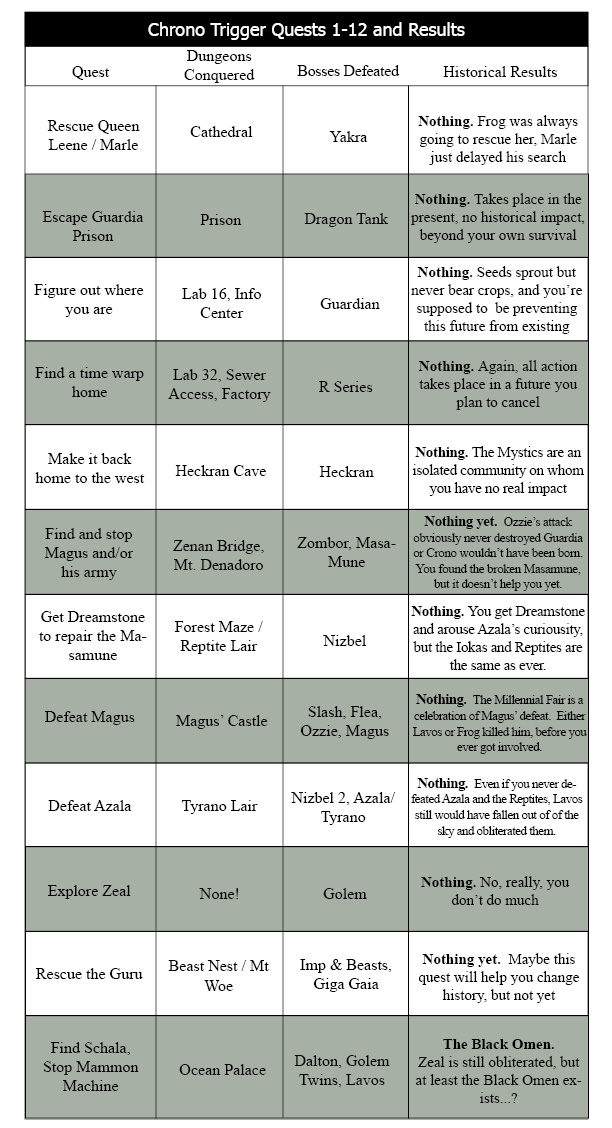
This is probably at odds with what the player feels. Look how many objectives were met! Look how many dungeons were crossed! Look how many bosses you thrashed! The player feels like they defeated Magus, that they defeated Azala, that they brought hope to the future, that they rescued Queen Leene, and so on. The truth is that all of those things are historically insignificant. The Millennial Fair is an event that commemorates the defeat of Magus.
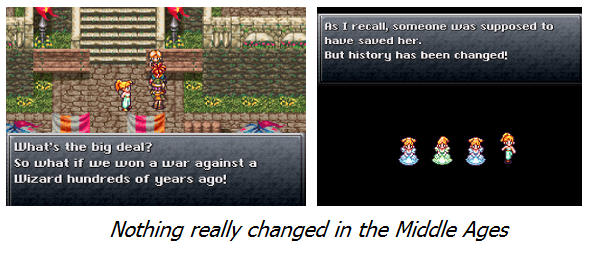
Presumably, Magus died while summoning Lavos, since his encounter with him at the Ocean Palace ends in defeat as well. The Reptites were wiped out by Lavos and the ice age that followed his arrival. The future remains as bleak as ever, despite the partyís actions, because Lavos still reigns over the wasteland. Thereís an ongoing theme here: Lavos is at the center of everything, and all attempts to change history are disrupted by his presence.
The point of the Tragedy of the Entity is to make the party--and the player, through the gameplay--understand the Entityís grief. The Entity and its fellow beings have been the victim of Lavos time and again. Lavos has destroyed civilizations and species, warped the planet to its own ends, and then sucked the life out of it. (The general consensus is that the Entity is a kind of animist incarnation of the planet, a kind of nature god.) The tragedy that culminates in the death of Crono is supposed to mirror the experience of the Entity for the player. Robo points this out in the second part of the game.
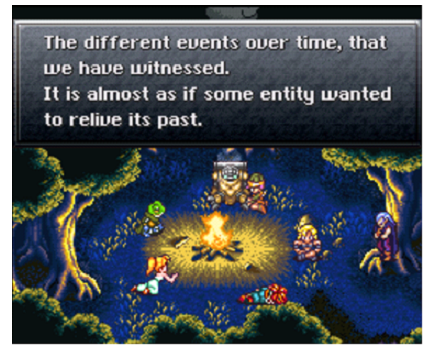
The player experiences the same frustration in reality that the Entity experiences in the game-world. Lavos cannot be defeated, and he takes away the playerís avatar--Crono--much like he takes away the planetís beloved creatures. And nowhere does the gameplay communicate this theme more clearly than in quest 13, the final moments of the Tragedy.
Quest 13: How it Feels to be Powerless
Stat of the Quest:Was Crono your best character? Well, it depends what you mean by that. From levels 20-60, dual techs that donít include Crono tend to be about 13% more powerful than those that do. On the other hand, Cronoís dual techs are more efficient; on average from levels 20-60 they deal about 18% more damage per point of MP spent. The percent difference also grows as characters approach level 99. This, I think, is a product of Crono having so many early, low-level dual techs with so many characters--techs essential to the playerís survival in the early game.
Quest 13 is easily the most annoying quest in the game, but this is entirely by design. The point of quest 13 is to act as the denouement to the tragedy that peaked in quest 12. Quest 13 adds insult to injury; not only has the player just lost the best character, the foundation of all their best techs, but now the game has taken away all the partyís gear and items too! Moreover, the party composition is locked, and as it happened suddenly, the party might be made up of some weaker B-squad characters. This is yet another example of the design of the game cohering to the plot and themes. A moment of despair and frustration for the characters is translated via the gameplay (very effectively) into a moment of despair and frustration for the player.
To compound the playerís frustration, quest 13 takes place in the gameís second maze. Mazes donít dominate Chrono Trigger, generally, and this one isnít that hard once the player can visualize the way the air ducts and cells overlap, but it does take a few minutes. Thereís only one instance where the player cannot access a room with an item chest in it from the main floor. That said, the main floor is a bit hazardous because, at best, one naked character is fighting at the beginning. Ayla can fight even without her gear, but if sheís using techs, sheís got nothing to replenish her MP with (and the same is true for whoever is healing). The Basher and Byte enemies are, fortunately, pathetic; they have HP and damage more suited to Denadoro or the Reptite Lair. But if Ayla wasnít in the main party and hasnít learned a lot of useful techs, it can be a nerve-wracking first trip through the dungeon for a newbie, as the HP of the party is slowly whittled away, lost in a maze.
The dungeon isnít meant to really be deadly; itís just meant to feel deadly, to feel intimidating because the player has lost Crono and all their gear. The Golem Boss is yet another part of this attempt to disconcert the player. The Golem Boss counts down as though he were about to unleash a wipeout attack--and so of course first time players start throwing out all manner of powerful dual techs to try to kill him. The countdown is a red herring, however. The boss seems like it might be dangerous, but itís just a trick to make the player feel edgy--and also to drain the partyís MP before facing Dalton who is quite easy and bears no further analysis.
PART TWO: THE COMEDY OF THE SAGES
One thing the player ought to have noticed while playing through the Tragedy of the Entity is that Chrono Trigger has, so far, been extremely linear. For a game ostensibly about time travel, this is curious. Even while in possession of a time machine, the player has been mostly unable to control where or when the party was headed. And as we noted before, whenever and wherever the party went, their lasting historical impact was either nothing or close to nothing, while the antagonist had a huge influence over the course of history. Indeed, not only was the quest linear in the first part of Chrono Trigger, but the world in which those quests took place was basically static. When the player finished a quest, there were very few signs of change, except for that some NPCs would react with a kind of ďWay to go!Ē phrase, if they were local to the events of the quest. This changes completely in the Comedy of the Sages; the player gains freedom, agency, variety in quest structures, and a much different ending.
To some degree, this style of second-half gameplay is built out of JRPG orthodoxy and Chrono Triggerís adherence to it, but there are a couple of reasons why the mold doesnít fit exactly. The key aspect of Chrono Trigger that separates it from typical JPRGs is that the difference between halves is much more marked than other JRPGs. It is a common structure in JRPGs for the end of the game to be more open, non-linear, varied, etc, than the beginning. The player has to master the systems the game teaches before being let loose to tackle the most difficult content. Chrono Trigger does fit this trend, and itís arguable that the second part of the game is merely the non-linear ending that many JRPGs of the 90s offered, but again those differences arise. First of all, most JRPGs of the time--especially Squaresoft titles--offered freedom earlier in the game. Final Fantasy games often see the player acquire an airship or other vehicle before the halfway point. That is, the player gets to practice some non-linear gameplay before itís the only option. In Chrono Trigger thereís really only one, fairly small detour (the Dactyl Nest/Hunting Grounds) thatís practical to do out of sequence. When the game opens up as a good JRPG should, the change is much more significant and far-reaching than in any JRPG contemporary. Those changes are, in short, a marked change in the style of quests away from typical dungeon fare, the full use of time-travel as a puzzle mechanic, and the ability to affect the game world in a way that most JRPGs donít see at all. Of course weíll get into specific examples of these things below.
Quest 14 - What Else is a Time Machine For?
Stat of the Quest:The Tragedy of the Entity contains more than two thirds of the quest-specific loot in the game (i.e. loot found on a quest, not just out in the world, like the sealed chests), but only 30% of those items are gear the player can wear. The rest are consumable items. During the Comedy of the Sages 43% of the remaining treasure is gear rather than consumable items. This is generally in line with RPG orthodoxy, where the best loot in the game has to be earned rather than purchased. Chrono Trigger is, however, a little more consumable-heavy than most RPGs in its endgame.
Quest 14, the last quest to be done in order before the game throws the gates completely open, functions as an introduction to how later quests will be different (although itís still mostly a typical quest). Until now the game has thrown a town, a dungeon, and a boss or two at the player during each quest. There will usually be a merchant who will sell a new set of gear somewhere along the way. Most dungeons have been basically divisible into two halves with a save point, or has been short enough that its structure was irrelevant (with a couple exceptions). Quest 14 sticks with some of this, but scrambles the order. Thereís no new town, but the merchant at Last Village has new equipment to sell. Instead of exploring a new geographic area, the party skips about through time to get the Time Egg, the Clone, and finally Balthasarís Pyozos. The noted lack of time-hopping is over now; players will be jumping all over time frequently from here on out.
Death Peak is still a two-part dungeon, but there are a few differences from the earlier template of combat sections. Enemy-wise, Death Peak should be a short dungeon. There are only 27 enemies, 21 of which are the dangerous but short-lived Krakker. And yet there are three bosses! The Lavos Spawn is a bit of a gimmick boss which the player might not recognize as an instance fierce counterattack at first because of a lack of phases or obvious parts. Any hits to the Spawnís shell will result in a high-damage counterattack. The tricky thing is that the battle cursor automatically starts on the shell, which will doom a few careless players. Even properly fought, itís not an easy fight the first time through--especially if Crono was the backbone of the playerís best dual and triple techs.
Whatís happening is that the game is preparing the player for a different kind of game to come. In a typical JRPG, dungeons in the back half of the game are longer, and thereís a lot less to do outside of them. In Chrono Trigger, dungeons generally get shorter and denser with more emphasis on difficult boss fights. In fact, two quests (both of which are hardly dungeons at all) are going to be exclusively boss fights. And, with a couple exceptions, all of the quests leading up to the Black Omen are going to be short and involve stops in different eras for completion. This is a departure from conventional JRPG design, but it works really well for Chrono Trigger. Time travel is fun, and the fact that the player has had to wait all game for these time-hopping adventures to start means that they donít need to have only long dungeons for entertainment.
Then thereís also the fact that this quest, and the quests that come after it, actually matter. At long last history can be meaningfully rewritten--beginning with the retrieval of a lost party member.
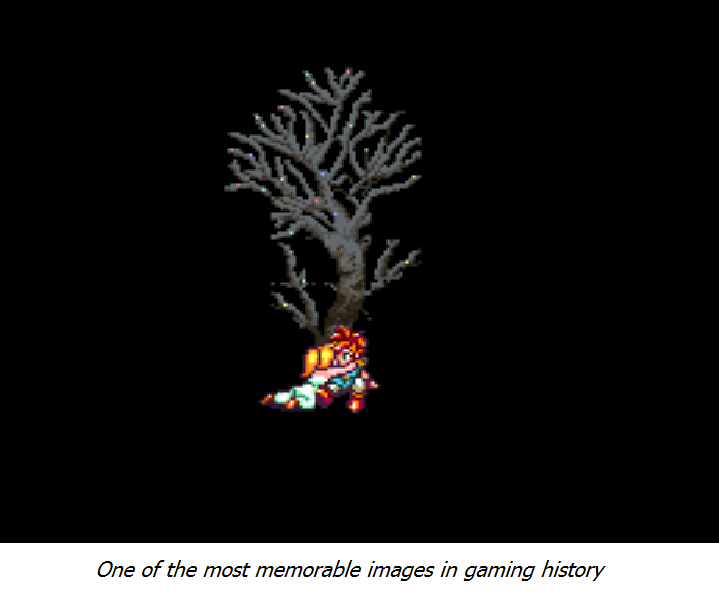
Quest A - Fiona's Forest
Stat of the Quest: The bosses in the second half of Chrono Trigger get harder, and the quests become non-linear. But one thing stays very linear throughout the second half of the game is the stat system; it is uncanny how linear it is, in fact.
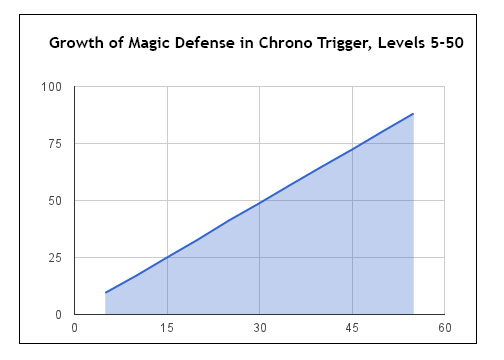
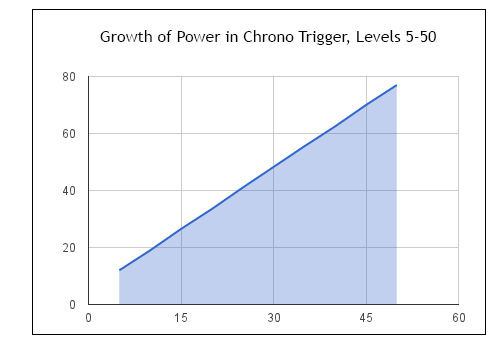
The linearity you see here is probably a product of the gameís broad intended audience (an issue weíll discuss more later). Thereís no really no peaks or valleys that would frustrate a player; one level is basically as valuable as the next.
The quests after the Blackbird can be done in any orderónot just theoretically in any order but actually in any order. That said, there is a useful ďgatewayĒ quest for the Comedy of the Sages: Fionaís forest. Itís not necessary to do the quest before going on to the others at all, but it works quite well as a spot-check for all the skills the player is going to need for this half of the game. If the player can do this quest and beat the boss, he can do the rest of the quests without too much trouble (or having to do too much grinding). The quest is definitely as dense as Death Peak would lead the player to expect. All 22 enemies are located in one room. It can actually get kind of annoying, in that regard, as every few steps will result in another battle. Depending on the playerís level and equipment, the encounters can be difficult. The Hexapod enemy has a high resistance to physical damage, and a lot of HP. Like most monsters of this sort, however, itís got a triggered vulnerability to exploit. Water-elemental attacks will lower the Hexapodís defenses, allowing for quicker kills. By now, the player almost certainly has either Ice 2 or Water 2, making sure that whole groups of Hexapods can be hit for their vulnerability at once.
The boss of the Sunken Desert, the Retinite, is a very important spot-check (a kind of challenge for which the stakes are multiple game overs) for the playerís understanding of party composition, making sure that multiple party members know their advanced techs, and making sure that the party has the gear it needs to survive the new challenges. This battle is probably the cleverest implementation of triggered vulnerability. The Retinite is almost completely immune to damage unless hit by a water-elemental attack, and much like Nizbel 2, the immunity returns after taking damage while vulnerable. Like Nizbel, this will force the player to abandon their comfort zone of dual-tech-and-heal and actually make a variety of decisions.
In order to do meaningful damage, either Frog, Marle or Magus needs to be constantly casting water spells. The other two party members are, presumably, using dual techs to deal damage. The problem is that while that one party member is casting water spells, he or she is not casting healing spells--and itís a fairly big problem because the Retinite dishes out a lot of shadow and physical damage. The party member casting water spells has to stop to heal, rendering the other two party members useless. Itís also not possible to bring both Marle and Frog, because the Retinite is immune to magic damage altogether, and all of the dual techs that Marle, Frog and Crono have are magical damage, except for X-Strike, which isnít that much damage compared to something like Beast Toss or Drop Kick. Then again, Drop Kick might still be a few hundred tech points away.
Thatís a bit confusing, understandably, but the point is that the Retinite will force the player player and the party are able to:
(1) Compose a party specific to individual challenges (2) Buy, find and equip the proper gear (including all that pendant-unlocked gear all over the world) (3) Learn techs for party members not in the main group (and understand which of those attacks are elemental and which are physical) (4) Grind out a few levels if necessaryAll of these are pretty essential skills for a non-linear environment. It wonít be easy the first time, but once the player can beat the Retinite, the rest of the gameís lessons should be fairly straightforward. (Too bad you canít go back to the Ocean Palace, right?)